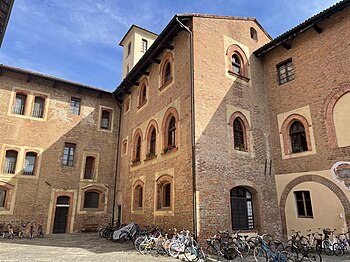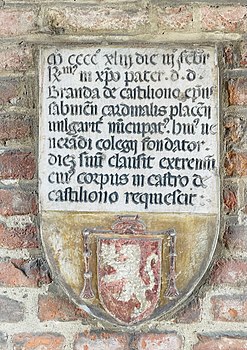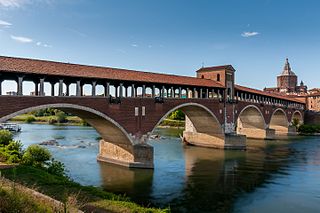
Pavia is a town and comune of south-western Lombardy, in Northern Italy, 35 kilometres south of Milan on the lower Ticino near its confluence with the Po. It has a population of c. 73,086.

Pope Pius VIII was head of the Catholic Church and ruler of the Papal States from 31 March 1829 to his death in November 1830.

Aloysius de Gonzaga, SJ was an Italian aristocrat who became a member of the Society of Jesus. While still a student at the Roman College, he died as a result of caring for the victims of a serious epidemic. He was beatified in 1605 and canonized in 1726.

The Church of St. Ignatius of Loyola at Campus Martius is a Latin Catholic titular church, of deaconry rank, dedicated to Ignatius of Loyola, the founder of the Society of Jesus, located in Rome, Italy. Built in Baroque style between 1626 and 1650, the church functioned originally as the chapel of the adjacent Roman College, which moved in 1584 to a new larger building and was renamed the Pontifical Gregorian University. It is one of the great 17th century preaching churches built by Counter-Reformation orders in the Centro Storico.

The University of Pavia is a university located in Pavia, Lombardy, Italy. There was evidence of teaching as early as 1361, making it one of the oldest universities in the world. It was the sole university in Milan and the greater Lombardy region until the end of the 19th century. In 2022, the university was recognized by the Times Higher Education among the top 10 in Italy and among the 300 best in the world. Currently, it has 18 departments and 9 faculties. It does not have a main campus; its buildings and facilities are scattered around the city, which is in turn called "a city campus". The university caters to more than 20,000 students who come from Italy and all over the world.

Pellegrino Tibaldi, also known as Pellegrino di Tibaldo de Pellegrini, was an Italian mannerist architect, sculptor, and mural painter.

The Collegio Clementino is a palace in Rome, central Italy, sited between the Strada del'Orso and the banks of the Tiber. It was founded by Pope Clement VIII in 1595, to host Slavonian refugees. Giacomo della Porta was commissioned to erect a suitable building to house them, which would be one of the aged architect's last projects. On February 25, 1601, Urban VIII shifted the Slavs to Loreto and refounded the Collegio Clementino as an elite school for young noblemen of every nation and the richest families in Rome. The musical tradition of the Collegio Clementino remained strong: Alessandro Scarlatti wrote oratorios for Carnival seasons and came up from Naples to oversee their production.

Thomas Basin (1412–1491) was a French bishop of Lisieux and historian.

Vincenzo Foppa was an Italian painter from the Renaissance period. While few of his works survive, he was an esteemed and influential painter during his time and is considered the preeminent leader of the Early Lombard School. He spent his career working for the Sforza family, Dukes of Milan, in Pavia, as well as various other patrons throughout Lombardy and Liguria. He lived and worked in his native Brescia during his later years.

Busnago is a comune (municipality) in the Province of Monza and Brianza in the Italian region Lombardy, located at a distance of 30 kilometres (19 mi) northeast of Milan.

Bonifacio Bembo, also called Bonfazio Bembo, or simply just Bembo, was a north Italian Renaissance artist born in Brescia in 1420. He was the son of Giovanni Bembo, an active painter during his time. As a painter, Bonifacio mainly worked in Cremona. He was patronized by the Sforza family and was commissioned to paint portraits of Francesco Sforza and his wife Bianca Maria Visconti. Scholars have credited him as the artist who produced a tarot card deck for the Visconti-Sforza families, now held in the Cary Collection of Playing Cards at Yale University. In the past century, art historians have begun to question the authenticity of his works, believing his only two secure works to be the portraits of Francesco and Bianca Maria Sforza. He is believed to have died sometime before 1482.
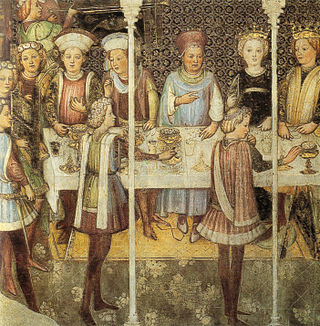
The Zavattari were a family of Italian painters active in Lombardy from the 14th to the 16th century.

For the former Borromeo College in the United States see Saint Mary Seminary and Graduate School of Theology#Borromeo College

The Almo Collegio Capranica is the oldest Roman college, founded in 1457 by Cardinal Domenico Capranica (1400–1458) in his own palace for thirty young clerics, who received an education suitable to prepare them for the priesthood.
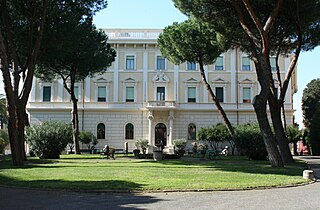
The Pontifical Irish College is a Catholic seminary in Rome for the training and education of priests. The college is located at #1, Via dei Santi Quattro, and serves as a residence for clerical students from all over the world. Designated a pontifical college in 1948, it is the last Irish College in continental Europe.

The Ghislieri College, founded in 1567 by Pope Pius V, is the second-oldest college in Pavia and co-founder of the IUSS in Pavia as well.

Pontifical Roman Athenaeum S. Apollinare is a former pontifical university in Rome, named after St. Apollinaris of Ravenna. Its facilities are now occupied by the Pontifical University of the Holy Cross.

Branda da Castiglione was an early Italian humanist, a papal diplomat and a Roman Catholic cardinal.
Giacomo Simonetta was an Italian Roman Catholic bishop and cardinal.

Morimondo Abbey is a former Cistercian monastery located at Morimondo, a few kilometers south of Abbiategrasso in the Metropolitan City of Milan, Lombardy, northern Italy. The surviving structure is Romanesque and Gothic. It was founded in 1134 as a daughter house of Morimond Abbey near Dijon, from which it took its name.

